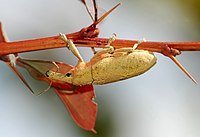
Photo from wikipedia
Changes in life history traits are often considered speciation triggers and can have dramatic effects on the evolutionary history of a lineage. Here, we examine the consequences of changes in… Click to show full abstract
Changes in life history traits are often considered speciation triggers and can have dramatic effects on the evolutionary history of a lineage. Here, we examine the consequences of changes in two life history traits, host‐type and phoresy, in the hypermetamorphic blister beetles, Meloidae. Subfamilies Nemognathinae and Meloinae exhibit a complex life cycle involving multiple metamorphoses and parasitoidism. Most genera and tribes are bee‐parasitoids, and include phoretic or nonphoretic species, while two tribes feed on grasshopper eggs. These different life strategies are coupled with striking differences in species richness among clades. We generated a mitogenomic phylogeny for Nemognathinae and Meloinae, confirming the monophyly of these two clades, and used the dated phylogeny to explore the association between diversification rates and changes in host specificity and phoresy, using state‐dependent speciation and extinction (SSE) models that include the effect of hidden traits. To account for the low taxon sampling, we implemented a phylogenetic‐taxonomic approach based on birth‐death simulations, and used a Bayesian framework to integrate parameter and phylogenetic uncertainty. Results show that the ancestral hypermetamorphic Meloidae was a nonphoretic bee‐parasitoid, and that transitions towards a phoretic bee‐parasitoid and grasshopper parasitoidism occurred multiple times. Nonphoretic bee‐parasitoid lineages exhibit significantly higher relative extinction and lower diversification rates than phoretic bee‐and grasshopper‐parasitoids, but no significant differences were found between the latter two strategies. This suggests that Orthopteran host shifts and phoresy contributed jointly to the evolutionary success of the parasitoid meloidae. We also demonstrate that SSE models can be used to identify hidden traits coevolving with the focal trait in driving a lineage's diversification dynamics.
Journal Title: Molecular Ecology
Year Published: 2022
Link to full text (if available)
Share on Social Media: Sign Up to like & get
recommendations!